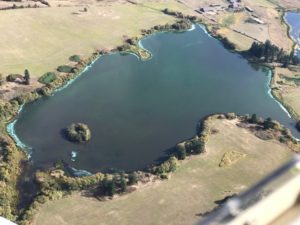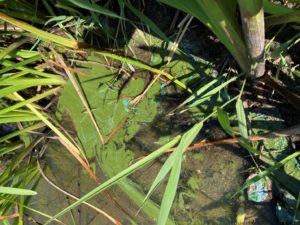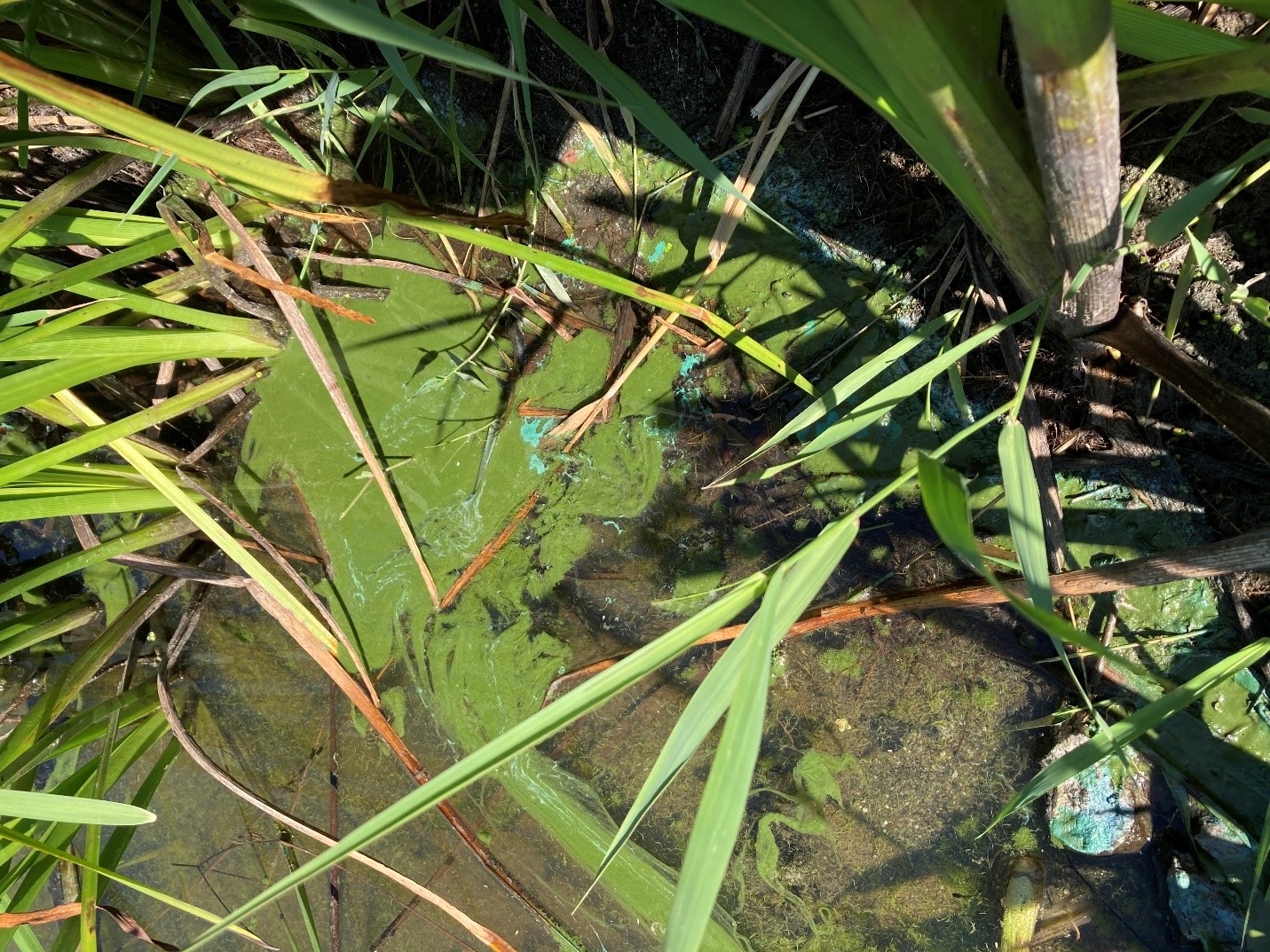
Cyanobacteria bloom at Zylstra Lake in October 2018
Zylstra Lake Preserve is easily the most complex project the Land Bank has taken on it its 30-year history. The property is currently open to access, operating under an interim management plan. This is the first in a series of articles intended to describe the background of this amazing preserve and the work that is going on to develop a long-term stewardship and management plan for the property.
Water is the most important element for creating and sustaining life on the planet. Perhaps it is this innate dependence and deep biological connection with water that draws us to water for recreation. Whether scenic views, boating, or swimming, water is often at the center of where we seek our literal re-creation. Water is also at the center of complexity at Zylstra Lake management as there is overlapping interest in recreational, agricultural, and ecological use and connection to this valuable and scarce resource. This article focuses on recreational access to the reservoir.
A small day-use area with swimming and boating access was part of the early vision for Zylstra. Although this level of use is a bit beyond the typical scope of the Land Bank’s “low intensity recreation” mandate, there was consensus within the Land Bank Commission that the recreational need for this type of water access on the island is high. The intention to move forward with this plan was elevated enough that the Land Bank began exploring potential partnership with other agencies who might help manage this more intense use while we simultaneously began a series of environmental assessments of the property.
Our first inkling that there might be some management challenges came in the form of algal bloom reports, including the photograph taken by local pilot and photographer Chris Teren (inset). Staff members began assembling research on algal blooms, especially cyanobacteria – a blue-green algae that matched observations. The following year, samples of the algae were sent for laboratory analysis when the blooms began in summer. The results confirmed the presence of potentially harmful types of cyanobacteria.
Around the same time, biologists working on an assessment of the property returned results of tests showing abnormally high levels of phosphorus, nitrogen, and related nutrient. The source of these compounds is not known with any certainty, but likely include several sources. These include feces from hyperabundant Canada goose population, legacy agricultural inputs from the property itself as well as upstream operations, and leaky septic systems, in addition to general erosion and pollutants.
The combination of these nutrients and the shallow, warm water of the lake create optimal conditions for cyanobacteria to thrive. Disturbance of sediment, as might be expected from recreational activities, releases suspended nutrients, increasing the likelihood of cyanobacteria blooms.
So what is the big deal with these blooms? Cyanobacteria harmful algal blooms have serious health consequences for humans and other animals. Mild reactions might include nausea, vomiting, diarrhea, earache, sore throat, swollen lips, blisters, dermatitis, or other maladies. More serious reactions include pneumonia or death. In our region a number of water bodies have reported cyanobacteria blooms, some of which have resulted in the death of dogs who swam or waded into the water.
Management wise, there is little available for the Land Bank to do to improve the situation or monitor for blooms. Neither removal of nutrients nor significantly decreasing the temperature of the reservoir are feasible. Accurate monitoring requires collection of water samples and sending them to a lab in Tacoma for analysis – a process which takes several days. Meanwhile, the severity of blooms can change in a matter of hours.
Conditions which can give rise to blooms are also anticipated to increase. Following structural safety review of the earthen dam by the Washington State Office of Dam Safety, the Land Bank was directed to lower storage level of the reservoir by four feet. This, combined with drawdown for agricultural uses, will result in the reservoir lowering an additional 4 to 6 feet than it has in recent memory, reducing the size of the reservoir by up to a third. Lowering will contribute to increased nutrient availability and elevated temperatures. In the long term, the impacts associated with climate change and sedimentation will further increase the threat of harmful algal blooms.
Based on this information, the Land Bank has elected to move slowly on the question of water access. Sanctioning swimming access seems irresponsible and boating access is complicated by changes in water level and potential of some simple contact-based health impacts. In the short term, we are asking the community to refrain from water access and to be careful around the water. Please keep your pets on leash and do not allow them to swim or drink the water. Fisherman are urged to be cautious when handling or consuming fish and are encouraged to wash their hands after fishing, especially when algal blooms are visually present.

Small cyanobacteria bloom at Zylstra Lake on July 1, 2021


